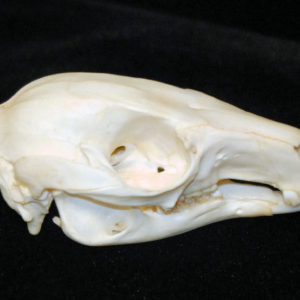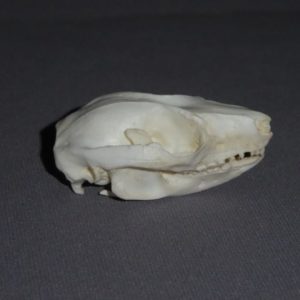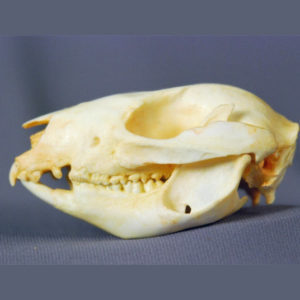All items sold on this website are polyurethane resin replicas, made in USA. No real or natural bone is available on this site.
Diprotodontia Tooth Molar & Tooth Tusk Replica measures 5.25 inches. Diprodontia Tooth Molar & Tusk Replica is museum quality polyurethane cast. Made in USA.
Diprotodontia or Diprotodon optatum, also called Giant wombat, is an extinct genus of marsupial classified in the suborder Vombatiformes and considered to be the largest known group of marsupial mammals. Its name in Latin means “two forward teeth.”
They lived during the Pleistocene Epoch (2.6 million to 11,700 years ago) in Australia and is a close relative of living wombats and koalas.
The oldest fossils of the genus Diprotodon come from late Pliocene deposits at Lake Kanunka, South Australia and Fisherman’s Cliff, New South Wales. Diprotodon optatum is known from the Pleistocene, becoming extinct at about 26,000 years ago.
Diprotodontia or Diprotodon stood about 6 feet tall at the shoulder and measured as much as 12 feet long. The largest specimens are thought to have weighed about 3 tons.
Diprotodontia or Diprotodon shares many skeletal, cranial, and dental features with its modern cousins, including two long forward-projecting lower incisors that occluded (that is, were brought into contact) with four square-shaped upper incisors.
Its molars and premolars had a series of lophs (ridges) running transversely from the cheek to the tongue.
These structures likely provided a grating mechanism for chewing, such that Diprotodon crushed and shredded the plant material in its diet in a manner similar to that of modern kangaroos.
The skull was massive and narrow with an unusually large nasal aperture, suggesting that the animal had a large nose or, possibly, a short tapirlike trunk.
Diprotodon is often referred to as a giant wombat, and it had a rear-facing pouch similar to a wombat. However this prehistoric wombat was also closely related to modern koalas. Its nose was much like the koala’s nose.
Diprotodon optatum evolved from Euryzygoma about two million years ago, and later it may have diverged into as many as three species.
Because of its large size, Diprotodon is considered (along with rhinoceroses, elephants, hippopotamuses, and horses) to be a megaherbivore.
Megaherbivores on many continents became extinct during the late Pleistocene. Diprotodon is thought to have succumbed to hunting due to the expansion of Australia’s human population.
The last known occurrence of Diprotodon was some 46,000 years ago. Its demise was part of a more general extinction of large Australian mammals that occurred between 72,000 and 44,000 years ago, when 14 out of 16 large mammal genera became extinct.
-
Black Forest Wallaby Skull
$86.00The Black dorcopsis or Black Forest Wallaby (Dorcopsis atrata) is a species of marsupial in the family Macropodidae. It is endemic to an island at the eastern end of New…
-
Brush-Tailed Rock Wallaby Skull
$91.00The Brush-tailed Rock Wallaby or small-eared rock-wallaby (Petrogale penicillata) is a kind of wallaby, one of several rock-wallabies in the genus Petrogale. It inhabits rock piles and cliff lines along…
-
Diprotodon Tooth Molar Replica
$24.00Diprotodon optatum species fossils have been found in sites across mainland Australia, including complete skulls and skeletons, hair, and foot impressions.
-
Diprotodon Tooth Tusk Replica
$29.00Diprotodon (Ancient Greek: “two protruding front teeth”) is an extinct genus of marsupial from the Pleistocene of Australia containing one species, D. optatum. The earliest finds date to 1.77 million…
-
Eastern Grey Kangaroo Disarticulated Skeleton
$2,900.00The Eastern Grey Kangaroo (Macropus giganteus) is a marsupial found in the eastern third of Australia, with a population of several million. It is also known as the Great Grey…
-
Eastern Grey Kangaroo Skeleton
$4,000.00The Eastern Grey Kangaroo (Macropus giganteus) is a marsupial found in the eastern third of Australia, with a population of several million. It is also known as the Great Grey…
-
Koala Male Skull Replica
$212.00The Koala (Phascolarctos cinereus), sometimes called the Koala Bear, is an arboreal herbivorous marsupial native to Australia. It is the only extant representative of the family Phascolarctidae and its closest…
-
Long-Nosed Potoroo Skull Replica
$106.00The Long-nosed Potoroo exhibits many morphological specializations such as an elongated pointed nose, erect ears, large eyes, claws for digging, and long robust hind legs. It is a small marsupial, with…
-
Northern Common Cuscus Skull
$91.00The Northern Common Cuscus is a pouched marsupial native to New Guinea and surrounding islands. They are nocturnal and primarily a fruit eater & occasionally prey on small vertebrates and…
-
Parma Wallaby Skull Replica
$91.00The Parma Wallaby (Notamacropus parma) is a small marsupial macropod mammal native to forests and densely-vegetated areas of northeastern New South Wales, Australia, close to the border with Queensland.
-
Pretty Faced Wallaby Skull
$91.00The Whiptail Wallaby (Notamacropus parryi), also known as the Pretty-faced Wallaby, is a species of wallaby found in eastern Australia. It is locally common from Cooktown in Queensland to near…
-
Ring-Tailed Possum Skull Replica
$91.00Ring-Tailed Possoms build a communal nest that is made up of an adult female, adult male, their dependent offspring and offspring of the previous year. Ringtail possums are territorial and…
-
Rufous Rat Kangaroo Skull
$91.00The Rufous Rat Kangaroo is the most widespread member of the Potoroidae family with populations found in Queensland, New South Wales and Victoria, Australia. It is a small nocturnal marsupial…
















